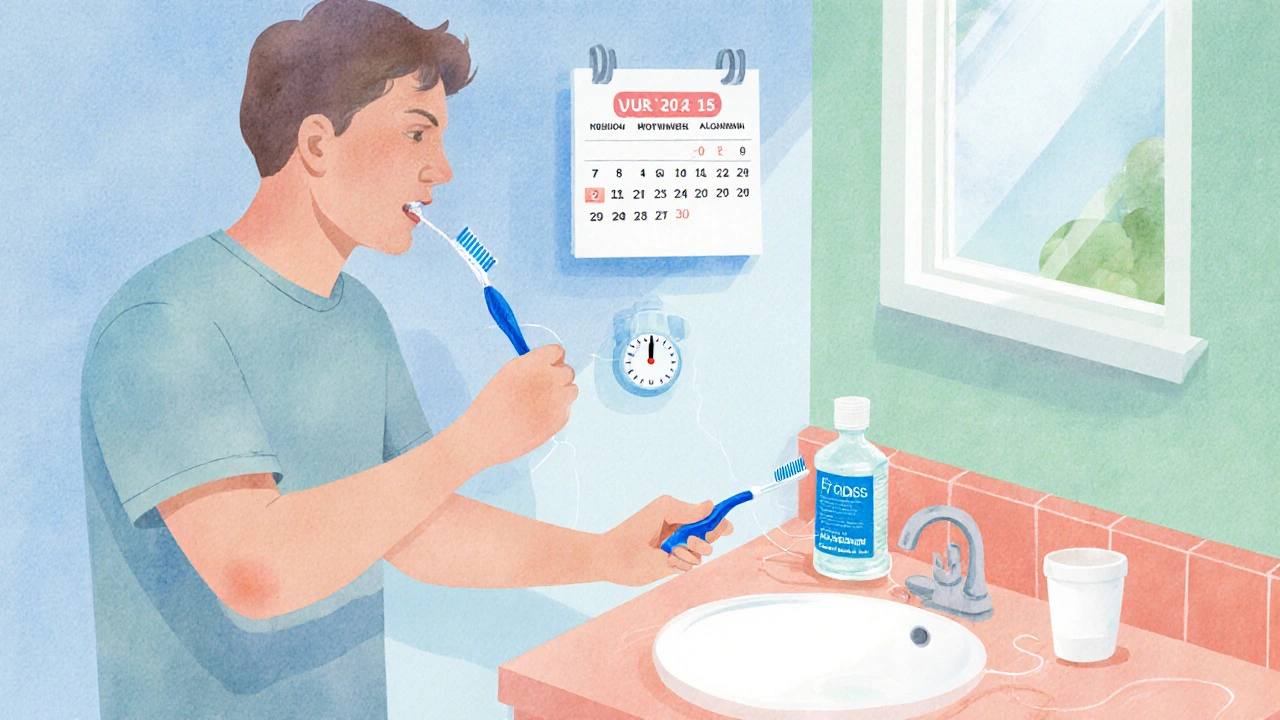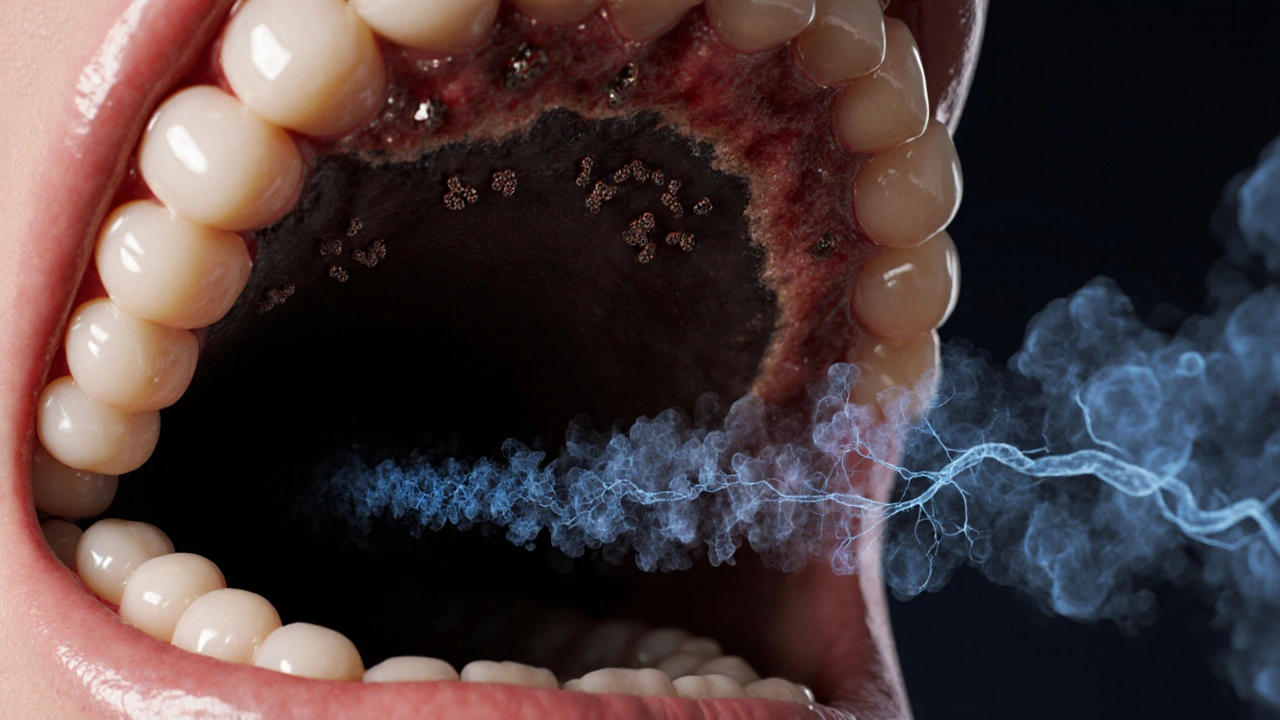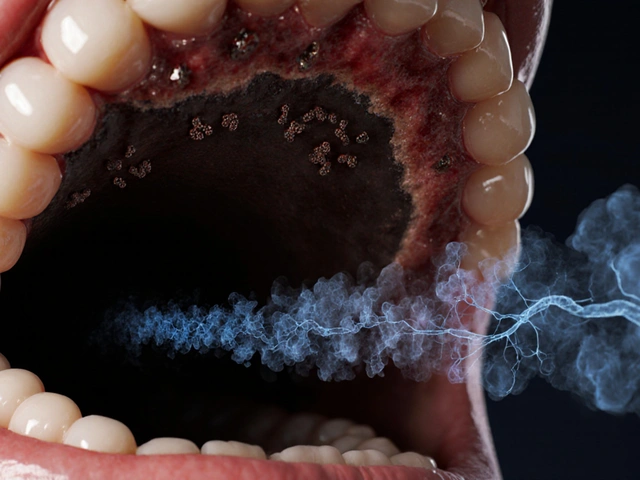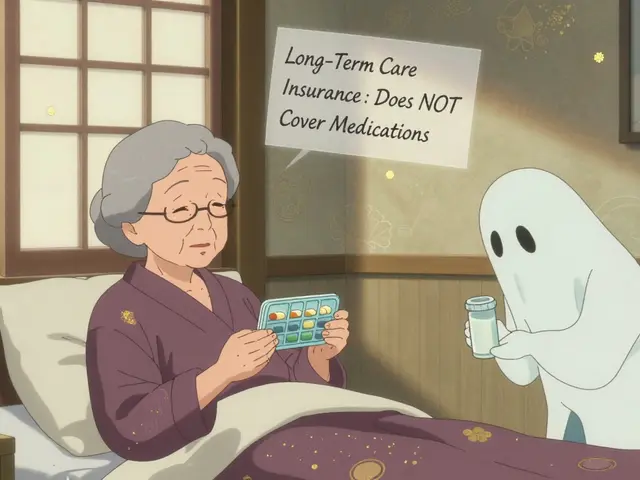Oral Health Impact Calculator
Your Oral Health Impact Score
When you think about lung health, the first thing that comes to mind is usually smoking or air quality. Yet a surprisingly powerful factor lives right in your mouth. Oral hygiene isn’t just about a bright smile - it’s a frontline defense against lung inflammation.
How the Mouth Connects to the Lungs
Understanding the link starts with a few key players. The first is dental plaque, a sticky film of bacteria that forms on teeth within hours of eating. If plaque isn’t removed, it hardens into tartar and can trigger periodontitis, a chronic gum disease.
Periodontitis creates deep pockets between teeth and gums where bacteria thrive. Those microbes don’t stay put - they can travel down the throat and be inhaled into the lower airways, a process known as aspiration. Over time, this can lead to aspiration pneumonia, an infection that inflames lung tissue.
Beyond infection, the constant presence of bacteria fuels an immune response that releases inflammatory chemicals into the bloodstream. Those chemicals can worsen existing respiratory conditions such as COPD or asthma, turning a mild flare‑up into a serious episode.
What the Research Says
Recent studies reinforce the clinical observations. A 2023 longitudinal study of 4,200 adults found that participants with poor oral health were 2.5 times more likely to develop chronic bronchitis over five years. Another 2024 meta‑analysis of 18 trials reported that intensive oral‑care programs reduced the incidence of hospital‑acquired pneumonia in intensive‑care patients by 30%.
These numbers aren’t just statistics; they translate into real‑world impact. For every 1,000 patients who adopt rigorous oral‑care habits, roughly 25 cases of lung inflammation can be avoided, saving both lives and healthcare costs.
Building an Effective Oral‑Hygiene Routine
Now that the stakes are clear, let’s break down a practical routine that targets the bacterial culprits.
- Brush twice daily with proper technique: Use a soft‑bristled brush, hold it at a 45‑degree angle to the gum line, and make gentle, short strokes. Spend at least two minutes, covering all surfaces.
- Replace your toothbrush every three months, or sooner if the bristles fray.
- Floss once a day: Flossing removes plaque from between teeth where brushes can’t reach. If traditional floss feels cumbersome, consider interdental brushes.
- Rinse with an antimicrobial mouthwash (alcohol‑free, containing chlorhexidine or essential oils) for 30 seconds to lower bacterial load.
- Stay hydrated. Saliva naturally washes away food particles and bacteria; drinking water throughout the day supports this process.
- Schedule professional cleanings every six months. Dental hygienists use ultrasonic scalers to break down tartar that home care can’t remove.
Consistency is the secret sauce. Skipping a day can let plaque rebound quickly, especially after meals high in sugar or starch.
Comparing Core Oral‑Care Tools
| Method | Frequency Recommended | Plaque Reduction* (%) | Typical Cost (AU$) | Ease of Use |
|---|---|---|---|---|
| Toothbrush (manual) | Twice daily | 70‑80 | 3‑5 | Very easy |
| Electric toothbrush | Twice daily | 85‑95 | 50‑120 | Easy, with timer |
| Dental floss | Once daily | 60‑70 (inter‑tooth) | 2‑4 | Moderate (technique needed) |
| Antimicrobial mouthwash | Once daily | 30‑50 (overall) | 8‑15 | Very easy |
*Values are averages from clinical trials comparing bacterial counts before and after one‑month use.

Who Is Most at Risk?
Not everyone faces the same danger level. Certain groups need extra attention:
- Elderly adults: Reduced saliva flow and dexterity make plaque control harder.
- People with chronic respiratory diseases (COPD, asthma): Their lungs are already inflamed; added bacterial load can trigger severe attacks.
- Smokers: Tobacco impairs gum tissue healing and encourages bacterial growth.
- Individuals with diabetes: High blood sugar fuels plaque formation and slows immune response.
If you fall into any of these categories, consider an intensified routine-twice‑daily flossing, a fluoride‑enhanced mouthwash, and quarterly dental visits.
Linking Dental Care with Medical Care
Doctors are increasingly asking patients about their oral‑health habits. When you visit your primary care physician for asthma or COPD, be ready to discuss your brushing frequency, flossing habits, and any gum bleeding you’ve noticed.
Conversely, dentists now screen for signs of respiratory trouble. If you experience chronic cough, shortness of breath, or frequent chest infections, bring that up at your dental appointment. Collaborative care can catch problems early, before they spiral into full‑blown lung inflammation.
Common Mistakes that Undermine Lung Health
Even with good intentions, many people slip up:
- Skipping night brushing: Nighttime is when saliva production drops, allowing bacteria to multiply unchecked.
- Using a hard‑bristled brush: It can damage gums, creating entry points for microbes.
- Relying solely on mouthwash: It reduces surface bacteria but doesn’t remove plaque from under the gum line.
- Ignoring bleeding gums: Bleeding signals inflammation-address it promptly with a dental check‑up.
Quick Takeaways
- Dental plaque is the primary source of bacteria that can travel to the lungs.
- Proper brushing, flossing, and regular professional cleanings cut the risk of lung inflammation by up to 30%.
- High‑risk groups (elderly, smokers, chronic‑respiratory patients) should adopt an intensified oral‑care routine.
- Coordination between dentists and physicians improves early detection of respiratory complications.
Frequently Asked Questions
Can poor oral hygiene really cause pneumonia?
Yes. Bacteria from untreated gum disease can be aspirated into the lungs, leading to infections that manifest as pneumonia, especially in older adults or people with weakened immune systems.
How often should I visit the dentist to protect my lungs?
For most people, a dental check‑up and cleaning every six months is enough. High‑risk individuals should consider quarterly visits to keep plaque levels low.
Is an alcohol‑free mouthwash better for lung health?
Alcohol‑free formulas are gentler on oral tissues and reduce the risk of drying out the mouth, which can otherwise let bacteria thrive. Look for products containing chlorhexidine or essential oils for the best antimicrobial effect.
What signs indicate my gum disease might be affecting my lungs?
Frequent coughing, recurring chest infections, or a noticeable increase in shortness of breath after meals could signal that oral bacteria are reaching the lungs. Discuss these symptoms with both your dentist and primary care doctor.
Do electric toothbrushes provide extra protection against lung inflammation?
Electric brushes generally remove more plaque than manual ones, especially in hard‑to‑reach areas. Higher plaque removal translates to fewer bacteria available for aspiration, offering modest added protection.








Winnie Chan
October 4, 2025 AT 13:51Wow, who knew brushing twice a day could actually keep your lungs from throwing a tantrum? Guess we’re all just one floss away from a breath of fresh air.
Kelvin Van der Maelen
October 4, 2025 AT 16:05You’re brushing wrong if you’re not doing it twice a day. This is basic hygiene, not rocket science.
Joy Arnaiz
October 4, 2025 AT 18:18It is plausible that pharmaceutical companies downplay the connection between oral bacteria and pulmonary inflammation, as acknowledging the link could shift public health priorities away from profitable treatments.
Christopher Eyer
October 4, 2025 AT 20:31The data on oral health affecting lung condition is overhyped; many studies dont account for confounding variables like diet or socioeconomic status, so conclusions are shaky.
Mike Rosenstein
October 4, 2025 AT 22:45Maintaining a consistent oral care routine-brushing twice daily, flossing, and regular dental check‑ups-not only supports dental health but also contributes to overall respiratory wellbeing.
Ada Xie
October 5, 2025 AT 00:58It is imperative that individuals adhere to meticulous oral hygiene practices, for neglect thereof may precipitate the proliferation of pathogenic microorganisms capable of inciting pulmonary inflammation.
Stephanie Cheney
October 5, 2025 AT 03:11Keep up the good work! Every extra minute you spend brushing or flossing is an investment in both your smile and your breathing.
Georgia Kille
October 5, 2025 AT 05:25Just floss daily 😊
Jeremy Schopper
October 5, 2025 AT 07:38Indeed, proper oral hygiene-brushing, flossing, and dental visits-is a cornerstone of respiratory health; neglecting these practices can lead to bacterial migration, inflammation, and compromised lung function!!
liza kemala dewi
October 5, 2025 AT 09:51The intricate relationship between oral microbiota and pulmonary health has been the subject of extensive investigation over the past decade. Emerging evidence suggests that pathogenic bacteria residing in dental plaque can aspirate into the lower respiratory tract, thereby initiating inflammatory cascades. This process is particularly consequential for individuals with preexisting respiratory conditions, such as asthma or chronic obstructive pulmonary disease. Moreover, systemic dissemination of oral pathogens via the bloodstream may exacerbate inflammatory responses beyond the oral cavity. Conversely, rigorous oral hygiene practices-including twice‑daily brushing with fluoride toothpaste, daily flossing, and periodic professional cleanings-serve to reduce bacterial load and interrupt this pathogenic trajectory. Studies employing quantitative polymerase chain reaction techniques have documented a markedly decrease in oral anaerobes following consistent plaque control measures. Such reductions correlate with lower concentrations of inflammatory markers, such as interleukin‑6 and tumor necrosis factor‑alpha, in sputum samples. It is also worth noting that the impact of oral health on lung inflammation is modulated by lifestyle factors, including smoking status, diet, and glycemic control in diabetic patients. Therefore, a holistic approach that integrates oral care with broader health interventions yields the most favorable outcomes. Clinicians are encouraged to advise patients on the significance of maintaining optimal oral hygiene as a preventive strategy against respiratory morbidity. Patient education materials should emphasize the mechanistic link between plaque accumulation and aspiration risk. In addition, interdisciplinary collaboration between dentists, pulmonologists, and primary care providers can facilitate comprehensive risk assessment. Insurance policies that cover routine dental prophylaxis may indirectly reduce healthcare expenditures associated with hospitalizations for pneumonia. Future research should aim to elucidate the molecular pathways through which oral bacteria influence alveolar macrophage activation. Such insights could pave the way for targeted therapeutics that complement conventional antimicrobial regimens. In sum, the preservation of oral health stands as a modest yet potent measure in the broader effort to safeguard pulmonary function and enhance quality of life.
Jay Jonas
October 5, 2025 AT 12:05Wow, that's a mountain of info! I gotta admit, I sometimes skip flossing because I'm too busy, but reading this makes me feel like my lungs are on a ticking clock-maybe I'll actually give my teeth some love.
Liam Warren
October 5, 2025 AT 14:18From a preventive medicine perspective, integrating interdental cleaning devices can augment plaque removal efficiency, thereby attenuating the bacterial load that contributes to endotoxin‑mediated pulmonary inflammation.
Brian Koehler
October 5, 2025 AT 16:31Absolutely! 🌟 Think of your mouth as the front line guard-equip it with a good brush, floss, and regular dental check‑ups, and you’ll keep the respiratory battleground clear of unwanted invaders.